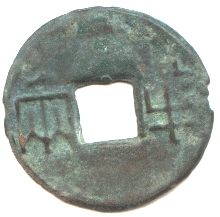copper coins
Copper has been used to make coins for centuries.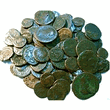 These stay around for years and it is impossible to guess how many times they have been passed from hand to hand. Normally we don't wash our hands before and after handling money. Yet this is potentially a good route for infections to spread. Copper, with its anti-bacterial properties, helps to stop this from happening. Bacteria do not survive on copper coins and since it is a non-allergenic material, people don't get a rash from handling them.
These stay around for years and it is impossible to guess how many times they have been passed from hand to hand. Normally we don't wash our hands before and after handling money. Yet this is potentially a good route for infections to spread. Copper, with its anti-bacterial properties, helps to stop this from happening. Bacteria do not survive on copper coins and since it is a non-allergenic material, people don't get a rash from handling them.
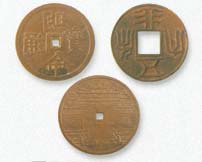 Several thousand years before the Christian era a flourishing civilization existed in Hindustan, and sites on the Indus are now being systematically examined. Farther east, in China, the general use of metals dates back to at least 2000 B.C., and by 1200 B.C. bronze foundry work had reached a high state of perfection. Although the Chinese claim to have used coins for money thousands of years before the Christian Era, none has been found which is earlier than the 3rd Century B. C. By then their well-known 'cash' had been introduced; this comprised copper discs with square holes in the centre through which string was threaded. This type of coinage lasted in China right down to the 20th Century.
Several thousand years before the Christian era a flourishing civilization existed in Hindustan, and sites on the Indus are now being systematically examined. Farther east, in China, the general use of metals dates back to at least 2000 B.C., and by 1200 B.C. bronze foundry work had reached a high state of perfection. Although the Chinese claim to have used coins for money thousands of years before the Christian Era, none has been found which is earlier than the 3rd Century B. C. By then their well-known 'cash' had been introduced; this comprised copper discs with square holes in the centre through which string was threaded. This type of coinage lasted in China right down to the 20th Century.
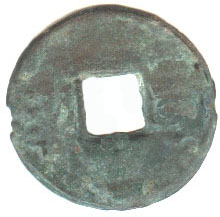
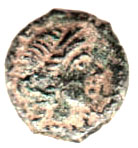
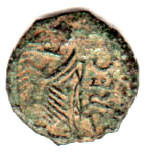 Celtic bronze coin of Volcae Arecomici c. 200 BCE. Volcae Arecomici was a Celtic tribe living in the southwestern Gaul (present day France). Obverse: Female head Reverse: A man standing wearing a toga and a palm tree in front of him and legend AREC. Weight: ~2 gms. Diameter: ~ 15 mm
Celtic bronze coin of Volcae Arecomici c. 200 BCE. Volcae Arecomici was a Celtic tribe living in the southwestern Gaul (present day France). Obverse: Female head Reverse: A man standing wearing a toga and a palm tree in front of him and legend AREC. Weight: ~2 gms. Diameter: ~ 15 mm
The Greeks mainly employed a silver coinage. It was beautifully minted, and bronze dies were used exclusively.
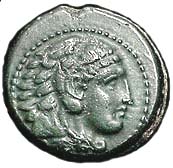
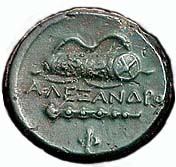 Alexander III. 356 - 323 BCE. Bronze coin 22mm. Coins of Alexander circulated in Persia after his conquest of Persia. Alexander issued massive number of coins all through his brief reign to facilitate the campaign of war. After his death Hellenistic Kingdom called Seleucid Kingdom established in the eastern parts of his empire. Persia became part of Seleucid Kingdom till 247 BCE. Coins of Seleucid Kingdom circulated in Persia.
Alexander III. 356 - 323 BCE. Bronze coin 22mm. Coins of Alexander circulated in Persia after his conquest of Persia. Alexander issued massive number of coins all through his brief reign to facilitate the campaign of war. After his death Hellenistic Kingdom called Seleucid Kingdom established in the eastern parts of his empire. Persia became part of Seleucid Kingdom till 247 BCE. Coins of Seleucid Kingdom circulated in Persia.
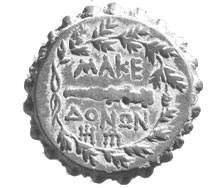 The back of a copper coin issued in Macedonia, northern Greece. The coin, which has a rare serrated edge, dates to 185-168 BC.
The back of a copper coin issued in Macedonia, northern Greece. The coin, which has a rare serrated edge, dates to 185-168 BC.
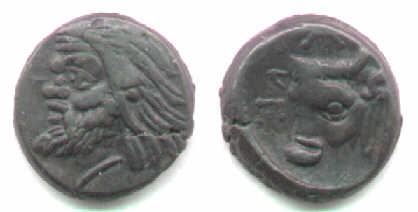 A Greek copper coin of the city Pantikapion, from the 4th century BC. Pan (notice the pun on the name of the city) / bull's head.
A Greek copper coin of the city Pantikapion, from the 4th century BC. Pan (notice the pun on the name of the city) / bull's head.
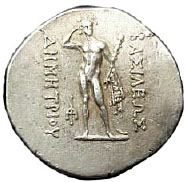
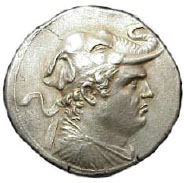 Tetradrchm of Demetrios I c. 200 - 190 BCE. Obverse: Draped bust wearing elephant scalp headdress. Reverse: Herakles holding club and lion's skin. Bactria (Zariaspa) was an ancient country lying between the mountains of the Hindu Kush and the Amu Darya (Present day Afghanistan, Uzbekistan, and Tajikistan). Demetrios I, son of Euthydemus II and grand son of Euthydemus I advanced his kingdom into the Hindu Kush and northwestern India. He established the Indo-Bactrian (Indo-Greek) branch of the kingdom in Indus Valley.
Tetradrchm of Demetrios I c. 200 - 190 BCE. Obverse: Draped bust wearing elephant scalp headdress. Reverse: Herakles holding club and lion's skin. Bactria (Zariaspa) was an ancient country lying between the mountains of the Hindu Kush and the Amu Darya (Present day Afghanistan, Uzbekistan, and Tajikistan). Demetrios I, son of Euthydemus II and grand son of Euthydemus I advanced his kingdom into the Hindu Kush and northwestern India. He established the Indo-Bactrian (Indo-Greek) branch of the kingdom in Indus Valley.
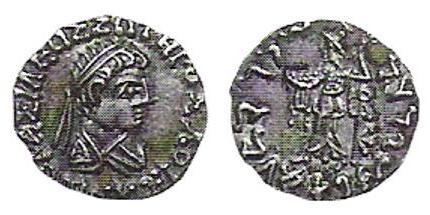 Square copper coin of king Dionysios (Greek r.c. 65 - 55 BCE).
Square copper coin of king Dionysios (Greek r.c. 65 - 55 BCE).
Obv: Bust of king Dionysios, diademed.
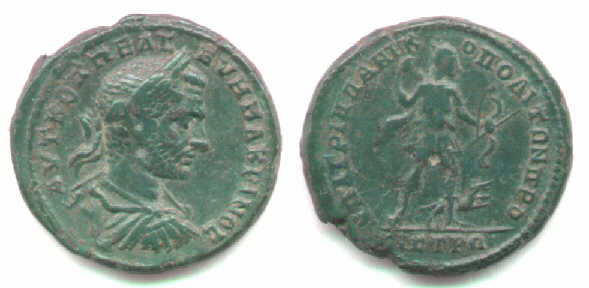 Diana, the huntress, known to the Greeks as Artemis, depicted in a short hunting skirt, with her bow and arrow and her hound. The coin is a "Roman provincial" copper piece (28mm diameter, substantially larger than a quarter, and with a lovely green patina) struck for Macrinus, Roman emperor 217-218AD, at Nicopolis ad Istrum (Bulgaria). The legend is in Greek and names Macrinus (2:00 - 5:00) on the obverse.
Diana, the huntress, known to the Greeks as Artemis, depicted in a short hunting skirt, with her bow and arrow and her hound. The coin is a "Roman provincial" copper piece (28mm diameter, substantially larger than a quarter, and with a lovely green patina) struck for Macrinus, Roman emperor 217-218AD, at Nicopolis ad Istrum (Bulgaria). The legend is in Greek and names Macrinus (2:00 - 5:00) on the obverse.
The Greeks used only a few copper coins, but the Romans had a large variety of copper money. As civilization progresses new materials are developed but older ones are rarely discarded; rather are they used more for specialized purposes, particularly if they are comparatively scarce.
The Development of Roman Coinage: Irregular lumps of bronze called AES RUDE, were the earliest known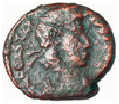 common measure of value in central Italy. They were followed chronologically by AES SIGNATUM, oblong, brick-shaped or quadrilateral cast pieces of bronze with a design on each side, such as an elephant, anchor, trident, etc. About 269 B.C., they were replaced by a proper form of coinage which included large round cast bronze coins, called AES GRAVE, for local commerce, and a series of silver coins, called didrachms, for trade with the Greek cities which had been established in southern Italy.
common measure of value in central Italy. They were followed chronologically by AES SIGNATUM, oblong, brick-shaped or quadrilateral cast pieces of bronze with a design on each side, such as an elephant, anchor, trident, etc. About 269 B.C., they were replaced by a proper form of coinage which included large round cast bronze coins, called AES GRAVE, for local commerce, and a series of silver coins, called didrachms, for trade with the Greek cities which had been established in southern Italy.
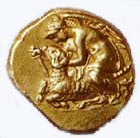 Billon is a mixture of silver and copper and sometimes other metals. The silver content is always less than the copper. The word billon comes from the middle Latin billio and means "a largely copper containing coin" or also simply "unit of payment".
Billon is a mixture of silver and copper and sometimes other metals. The silver content is always less than the copper. The word billon comes from the middle Latin billio and means "a largely copper containing coin" or also simply "unit of payment".
 Bronze As of Tiberius 14 CE - 37CE. Obverse: Laureate head left . Reverse:Winged caduceus. Mint: Moneyer: Weight: ~ 10 g.
Bronze As of Tiberius 14 CE - 37CE. Obverse: Laureate head left . Reverse:Winged caduceus. Mint: Moneyer: Weight: ~ 10 g.
Here is a large (27 mm diameter) Roman copper coin (with some silver on the surface, a nummus also called a follis) of Severus II, Caesar from 305 - 306 AD and Augustus (= emperor) from 306 - 307 AD. The legend, FL VAL 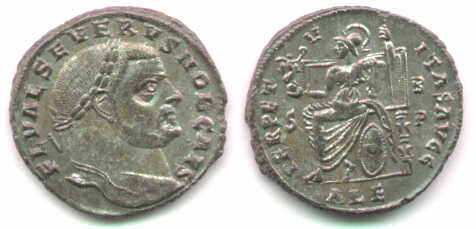 SEVERVS NOB CAES, tells us his name, "FLavius VALerius SEVERUS" and that he was "NOBilis CAESar" = "Noble Caesar" at the time and not yet emperor (Augustus). The reverse says "PERPETVITAS AVGG" ("immortality of the emperors" [like the word "perpetual"]) and shows Roma (the city, personified) seated left holding a tiny Victory with a wreath, and a sceptre. An oval shield is below. The coin was minted at ALE(xandria), Egypt.
SEVERVS NOB CAES, tells us his name, "FLavius VALerius SEVERUS" and that he was "NOBilis CAESar" = "Noble Caesar" at the time and not yet emperor (Augustus). The reverse says "PERPETVITAS AVGG" ("immortality of the emperors" [like the word "perpetual"]) and shows Roma (the city, personified) seated left holding a tiny Victory with a wreath, and a sceptre. An oval shield is below. The coin was minted at ALE(xandria), Egypt.
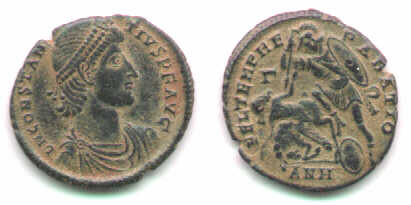 This is a quarter-sized copper coin of Constantius II, Roman emperor from 337 to 361 AD. On the obverse Roman imperial coins have legends which name the emperor and give some of his titles, like this one that says "DN CONSTANTIVS PF AVG". Legends on the reverse usually relate to the reverse design. On this reverse is a battle scene with a large foot soldier thrusting his spear downward into a smaller (Persian) horseman who turns back to ward off the spear as his tiny horse falls and begins to tumble over its head. The reverse legend FEL TEMP REPARATIO translates to "Happy times are restored!" or "Happy times are here again!
This is a quarter-sized copper coin of Constantius II, Roman emperor from 337 to 361 AD. On the obverse Roman imperial coins have legends which name the emperor and give some of his titles, like this one that says "DN CONSTANTIVS PF AVG". Legends on the reverse usually relate to the reverse design. On this reverse is a battle scene with a large foot soldier thrusting his spear downward into a smaller (Persian) horseman who turns back to ward off the spear as his tiny horse falls and begins to tumble over its head. The reverse legend FEL TEMP REPARATIO translates to "Happy times are restored!" or "Happy times are here again!
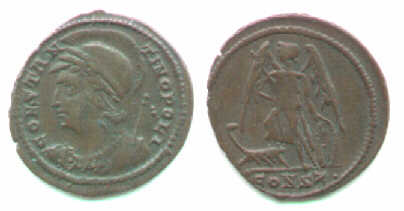 This is a very common copper coin minted in 333-334 AD near the end of the reign of Constantine the Great. It celebrates the foundation of a new capital city named in his honor, CONSTANTINOPOLIS, "Constantine's city." The obverse bust is not of Constantine, but of the city herself, personified as a helmeted warrior with a scepter (denoting power) over her shoulder. The reverse shows Victory with her foot on a tiny ship's prow. It commemorates a naval battle which secured the site of the city for Constantine.
This is a very common copper coin minted in 333-334 AD near the end of the reign of Constantine the Great. It celebrates the foundation of a new capital city named in his honor, CONSTANTINOPOLIS, "Constantine's city." The obverse bust is not of Constantine, but of the city herself, personified as a helmeted warrior with a scepter (denoting power) over her shoulder. The reverse shows Victory with her foot on a tiny ship's prow. It commemorates a naval battle which secured the site of the city for Constantine.
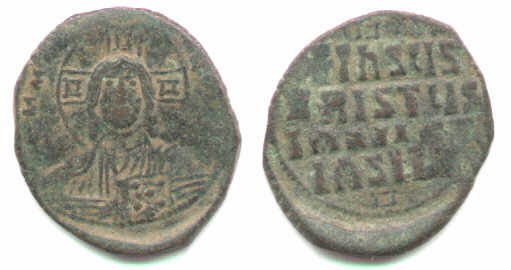 A large (32 mm) Byzantine copper coin of Basil II ("the Bulgar Slayer") and Constantine VIII, AD 976 - 1028. The obverse shows a facing bust of Christ (with a halo) and the reverse says "Jesus Christ, ruler of kings" in Greek.
A large (32 mm) Byzantine copper coin of Basil II ("the Bulgar Slayer") and Constantine VIII, AD 976 - 1028. The obverse shows a facing bust of Christ (with a halo) and the reverse says "Jesus Christ, ruler of kings" in Greek.
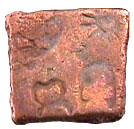
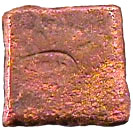
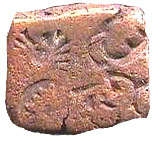
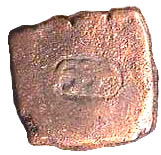 Muaryan empire (India c. 340 - 181 BCE) coins differed from others by having five punches and always including a sun symbol in those punches. Mauryan empire also introduced for the first time in India square shaped copper coins with punch marks.
Muaryan empire (India c. 340 - 181 BCE) coins differed from others by having five punches and always including a sun symbol in those punches. Mauryan empire also introduced for the first time in India square shaped copper coins with punch marks.
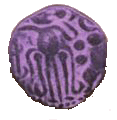 Sri Lanka copper coins issued by the Chola ruler Rajaraja Chola (985-1014) are excavated from many parts of Sri Lanka. The obverse and reverse of these coins are similar to the common Dambadeniya Massa coins issued by later Kalinga and Pandya rulers of Sri Lanka. This prototype for the Dambadeniya coins uses Tamil characters on the reverse for the kings name.
Sri Lanka copper coins issued by the Chola ruler Rajaraja Chola (985-1014) are excavated from many parts of Sri Lanka. The obverse and reverse of these coins are similar to the common Dambadeniya Massa coins issued by later Kalinga and Pandya rulers of Sri Lanka. This prototype for the Dambadeniya coins uses Tamil characters on the reverse for the kings name.
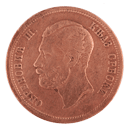 Serbian copper coin of 20 "para" with head of knez Mihaila Obrenovića from 1868.
Serbian copper coin of 20 "para" with head of knez Mihaila Obrenovića from 1868.
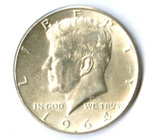
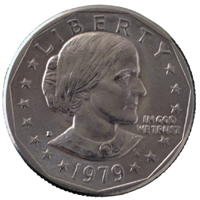 The U.S. nickel is actually 75% copper. The dime, quarter, and half dollar coins contain 91.67% copper and the Susan B. Anthony dollar is comprised of 87.5% copper.
The U.S. nickel is actually 75% copper. The dime, quarter, and half dollar coins contain 91.67% copper and the Susan B. Anthony dollar is comprised of 87.5% copper.
184,000 tones of copper were used for the first production of the eight new Euro coins.
- the €1 coin has a golden coloured outer ring made of an alloy called nickel brass. This is 75% copper, 20% zinc and 5% nickel. The centre is silver coloured made from nickel coated with an alloy of 75% copper and 25%
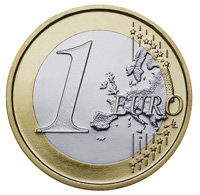 nickel.
nickel. - the €2 is similar with the alloys reversed;
- the 10, 20 and 50 cent coins contain 89% copper and the 1, 2 and 5 cents are copper-coated steel.
Sources:
http://www.worldcoincatalog.com
In our offer we also have:
● Copper tubes for LPG vehicles ![]()
Click on the links above to see more product details.
 sitemap
sitemap
Search
eng rus ger pol ita ned swe jpn srb cro esp chi por kor hun fra
Product range
- Copper tubes and pipes:
-
 Soft copper tubes
Soft copper tubes -
 Half-hard copper tubes
Half-hard copper tubes -
 Hard copper tubes
Hard copper tubes -
 PVC coated copper tubes
PVC coated copper tubes
-
 Copper pipes for LPG
Copper pipes for LPG -
 Tubes for refrigeration and AC
Tubes for refrigeration and AC Tubes for plumbing
Tubes for plumbing -
 Capillary tubes
Capillary tubes -
 Conductors, cables and wire
Conductors, cables and wire -
 Enamelled copper wire
Enamelled copper wire -
 Copper bars, rods and plates
Copper bars, rods and plates Brass and bronze bars and tubes
Brass and bronze bars and tubes -
 Copper strips and sheets
Copper strips and sheets -
 Copper, bronze, brass ingots
Copper, bronze, brass ingots -
 Trolley wire
Trolley wire -
 Copper fittings (pdf)
Copper fittings (pdf) -
 Contact details
Contact details -
 Careers
Careers
Other products:
Interesting facts
-
 Tables of standards
Tables of standards -
 Copper through history
Copper through history -
 Application of copper tubes
Application of copper tubes -
 Advantages of copper tubes
Advantages of copper tubes -
 Copper ore
Copper ore -
 Brass and bronze
Brass and bronze -
 Copper-containing minerals
Copper-containing minerals -
 Copper facts
Copper facts -
 Symbols of copper
Symbols of copper -
 Copper coins
Copper coins -
 The Baghdad Battery
The Baghdad Battery -
 Links
Links
